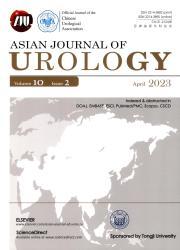Investigation of the clinical significance of the expression of immunohistochemical biomarkers Enhancer of zeste homolog 2 and Forkhead box M1 in localized prostate cancer tissue: A Greek retrospective study
IF 2.4
3区 医学
Q2 UROLOGY & NEPHROLOGY
引用次数: 0
Abstract
Objective
In recent decades, studies have underscored nuclear proteins and signaling pathways in prostate cancer (PCa) development. Key biomarkers like Enhancer of zeste homolog 2 (EZH2) and Forkhead box M1 (FOXM1) are expressed in both healthy and malignant prostate cells. This study aimed to demonstrate the relationship between pathological characteristics, survival, recurrence, and tissue expression of EZH2 and FOXM1 in high-risk PCa patients.
Methods
PCa tissues were used in a retrospective analysis that spanned from September 2009 to August 2019. Inclusion criteria comprised pathological tumor stage (pT) 3 patients with positive surgical margins or tumor proximity to inked margins within 5 mm. After case selection, tissue slides were stained for EZH2 and FOXM1 antibodies, and Allred scores were calculated. Patients or relatives of deceased patients were contacted for signed agreements and disease follow-ups.
Results
The pT3b, ductal carcinoma component, and moderate EZH2 expression were associated with relapse (odds ratio [OR] 6.21, 95% confidence interval [CI] 1.41–27.27, p=0.016; OR 7.29, 95% CI 1.03–51.43, p=0.046; OR 5.96, 95% CI 1.09–32.48, p=0.039; respectively). The unilateral and bilateral seminal vesicle invasion increased the likelihood of recurrence by 9.98 times and 5.36 times, and the risk of death by around 9.78 times and 10.79 times, respectively. The pT3b was linked to higher death likelihood (OR 7.16, 95% CI 1.38–37.23, p=0.019), while moderate EZH2 expression did not show statistical significance (OR 4.54, 95% CI 0.87–23.60, p=0.072, marginally). Pathological regional lymph node stage (pN) 1 had significantly higher probability of mortality than pN unknown (3.9% vs. 27%, p<0.001). PCa in the neck and apex of the prostate gland increased death risk tenfold.
Conclusion
Sufficient immunoexpression of EZH2, ductal carcinoma component, and neoplastic proliferation in the seminal vesicles, apex and neck of the prostate gland correlates with elevated risks of recurrence and mortality. Clinicians should use these criteria for appropriate patient referrals, and a multicenter trial could provide accurate classifications.
免疫组织化学标志物Enhancer of zeste homolog 2和Forkhead box M1在局限性前列腺癌组织中表达的临床意义:一项希腊回顾性研究
目的近几十年来,研究强调了核蛋白和信号通路在前列腺癌(PCa)发展中的作用。关键生物标志物如zeste同源物增强子2 (EZH2)和叉头盒M1 (FOXM1)在健康和恶性前列腺细胞中均有表达。本研究旨在探讨EZH2和FOXM1在高危PCa患者中的病理特征、生存、复发及组织表达之间的关系。方法回顾性分析2009年9月至2019年8月spca组织。纳入标准包括病理肿瘤分期(pT) 3的患者,手术切缘阳性或肿瘤靠近浸润切缘5毫米内。病例选择后,对组织切片进行EZH2和FOXM1抗体染色,计算Allred评分。联系患者或已故患者家属签署协议并进行疾病随访。结果pT3b、导管癌成分和中度EZH2表达与复发相关(比值比[OR] 6.21, 95%可信区间[CI] 1.41 ~ 27.27, p=0.016; OR 7.29, 95% CI 1.03 ~ 51.43, p=0.046; OR 5.96, 95% CI 1.09 ~ 32.48, p=0.039)。单侧和双侧精囊受累使复发的可能性分别增加9.98倍和5.36倍,死亡风险分别增加约9.78倍和10.79倍。pT3b与较高的死亡可能性相关(OR 7.16, 95% CI 1.38 ~ 37.23, p=0.019),而中度EZH2表达无统计学意义(OR 4.54, 95% CI 0.87 ~ 23.60, p=0.072,边缘)。病理性区域淋巴结分期(pN) 1的死亡率明显高于pN未知的死亡率(3.9% vs. 27%, p<0.001)。前列腺颈部和前列腺顶端的前列腺癌使死亡风险增加了10倍。结论EZH2、导管癌成分及前列腺精囊、前列腺尖部和前列腺颈部肿瘤增生与前列腺癌复发和死亡风险增高有关。临床医生应该使用这些标准进行适当的患者转诊,多中心试验可以提供准确的分类。
本文章由计算机程序翻译,如有差异,请以英文原文为准。
求助全文
约1分钟内获得全文
求助全文
来源期刊

Asian Journal of Urology
UROLOGY & NEPHROLOGY-
CiteScore
4.00
自引率
3.80%
发文量
100
审稿时长
4 weeks
期刊介绍:
Asian Journal of Urology (AJUR), launched in October 2014, is an international peer-reviewed Open Access journal jointly founded by Shanghai Association for Science and Technology (SAST) and Second Military Medical University (SMMU). AJUR aims to build a communication platform for international researchers to effectively share scholarly achievements. It focuses on all specialties of urology both scientifically and clinically, with article types widely covering editorials, opinions, perspectives, reviews and mini-reviews, original articles, cases reports, rapid communications, and letters, etc. Fields of particular interest to the journal including, but not limited to: • Surgical oncology • Endourology • Calculi • Female urology • Erectile dysfunction • Infertility • Pediatric urology • Renal transplantation • Reconstructive surgery • Radiology • Pathology • Neurourology.
 求助内容:
求助内容: 应助结果提醒方式:
应助结果提醒方式:


